Toyota 7FBMF 16, 18, 20, 25, 30 Service Manual
...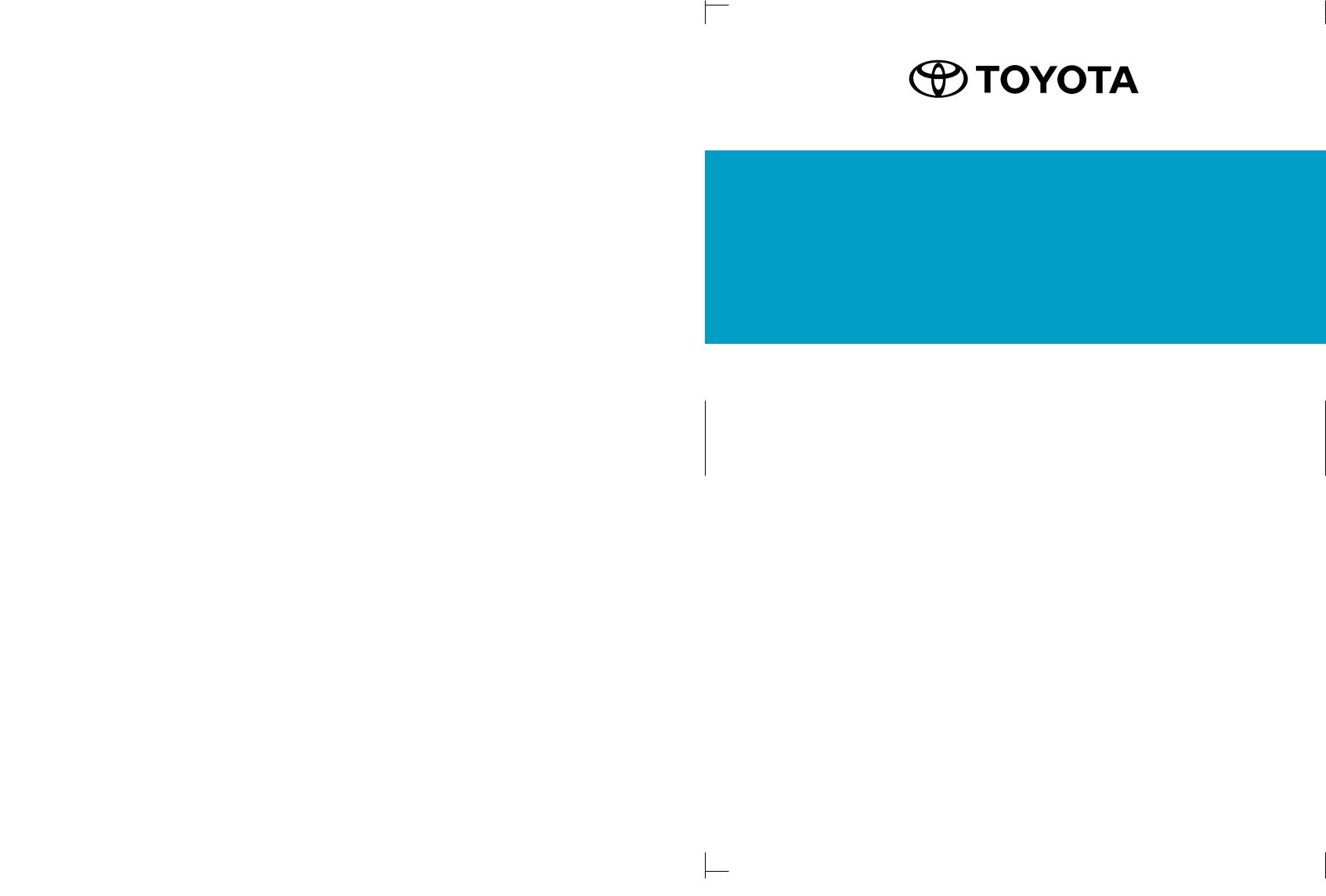
ELECTRIC FORKLIFT TRUCKS
7FBMF 16,18 7FBMF 20,25
7FBMF 30,35 7FBMF 40,45,50
< Tillbaka till Servicemanual 7FBMF 16-50
AUGUST 2002
Index
Pub. No. PE313
SECTION INDEX
NAME |
SECTION |
|
|
|
|
GENERAL |
0 |
|
|
DEVELOPMENT OBJECTIVES |
1 |
|
|
CONTROLLER |
2 |
|
|
MULTIPLE DISPLAY |
3 |
|
|
BATTERY |
4 |
|
|
POWER TRAIN |
5 |
|
|
STEERING & REAR AXLE |
6 |
|
|
TIRES |
7 |
|
|
OPERATOR’S COMPARTMENT |
8 |
|
|
BODY & ACCESORIES |
9 |
|
|
MATERIAL HANDLING & HYDRAULICS SYSTEM |
10 |
|
|
SAS |
11 |
|
|
MAIN OPTIONS & ATTACHMENTS |
12 |
|
|
WIRING DIAGRAM |
13 |

FOREWORD
This manual mainly describes the development objectives of new Toyota forklift 7FBMF16~50 models, outlines of main component units, structures and functions of new mechanisms and other technical features.
Please read it carefully for sales and service activities.
This manual has been edited for the vehicles launched into the market in September 2002.
Any later change shall be informed through Toyota Industrial Equipment Parts & Service News.
Please refer to the repair manual and parts catalog for the matters necessary for servicing.

GENERAL
|
Page |
VEHICLE EXTERIOR VIEWS |
.................................................. 0-2 |
MODEL LINE-UP ........................................................................ |
0-3 |
STANDARD EQUIPMENTS..................................................... |
0-4 |
0-1
0
0
11
12
13

0-2
VEHICLE EXTERIOR VIEWS
7FBMF16~35 |
7FBMF40~50 |
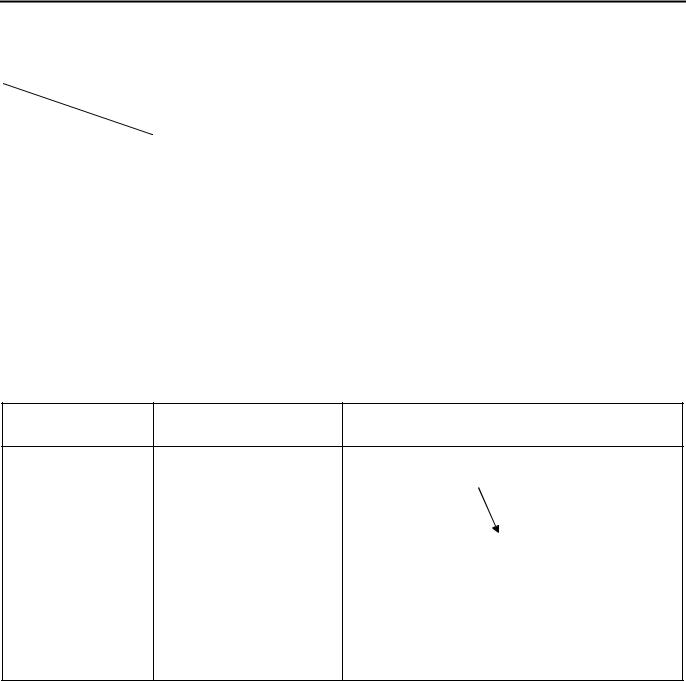
0-3
MODEL LINE-UP
Models
|
Capacity |
Model (80V or 72 V) |
|
|
||
|
|
|
|
|
||
|
(Load Center 500 mm) |
New |
Previous |
|
|
|
|
|
|
|
|||
|
|
|
|
|
|
|
1 ton Series |
1.6 ton |
7FBMF16 |
FBMF16 |
|
|
|
|
|
|
|
|
||
|
|
|
|
0 |
||
1.8 ton |
7FBMF18 |
— |
|
|||
|
|
|||||
|
|
|
|
|
||
2 ton Series |
2.0 ton |
7FBMF20 |
FBMF20 |
|||
|
|
|||||
|
|
|||||
|
|
|
|
|
||
2.5 ton |
7FBMF25 |
FBMF25 |
|
|
||
|
|
|
||||
|
|
|
|
|
|
|
3 ton Series |
3.0 ton |
7FBMF30 |
FBMF30 |
|
|
|
|
|
|
|
|
||
3.5 ton |
7FBMF35 |
— |
|
|
||
|
|
|
||||
|
|
|
|
|
|
|
|
4.0 ton |
7FBMF40 |
— |
|
|
|
|
|
|
|
|
|
|
4 ton Series |
4.5 ton |
7FBMF45 |
— |
|
|
|
|
|
|
|
|
|
|
|
5.0 ton |
7FBMF50 |
— |
|
|
|
|
|
|
|
|
|
|
Frame number stamping
Stamping Style
Model Stamping Location
(Starting Number)
7FBMF16 |
7FBMF18 |
10011 |
Stamp on LH & upper surface of front cross plate |
|||||
|
|
|
|
|
|
|||
7FBMF18 |
||||||||
|
|
|
|
|
|
|
||
|
|
|
|
|
|
|
|
|
7FBMF20 |
7FBMF25 |
10011 |
|
|
|
|
|
|
|
|
|
|
|
|
|||
7FBMF25 |
|
|
|
|
|
|||
|
|
|
|
|
|
|
||
|
|
|
|
|
|
|
||
|
|
|
|
|
|
|
|
|
7FBMF30 |
7FBMF35 |
10011 |
|
|
|
|
|
|
|
|
|
|
|
||||
|
|
|
|
|
||||
|
|
|
|
|
|
|||
7FBMF35 |
|
|
|
|
|
|||
|
|
|
|
|
|
|
||
|
|
|
|
|
|
|
|
|
7FBMF40 |
|
|
|
|
|
|
|
|
|
|
|
|
|
|
|
|
|
7FBMF45 |
7FBMF50 |
10011 |
|
|
|
|
|
|
|
|
|
|
|
|
|
|
|
7FBMF50 |
|
|
|
|
|
|
|
|
0
11
12
13

0-4
STANDARD EQUIPMENTS
|
|
|
: STD P:OPT |
—: Not Available |
|
|
|
|
|
|
|
|
Standard Equipment |
1.6-3.5 ton |
4.0-5.0 ton |
|
Note |
|
|
|
|
|
|
Electrical |
AC Power system for travelling & load handling |
|
|
|
|
System |
|
|
|
|
|
AC Power controller for steering |
— |
|
1.6-3.5 ton: DC system |
||
|
|
||||
|
|
|
|
|
|
|
Multiple display (All round model) |
P |
P |
|
|
|
|
|
|
|
|
Chassis |
SAS (System of Active Stability) |
|
|
|
|
|
|
|
|
|
|
|
Wet brake system |
|
|
|
|
|
|
|
|
|
|
|
Parking brake system of electric switch type |
|
|
|
|
|
|
|
|
|
|
|
Full hydraulic power steering |
|
|
|
|
|
|
|
|
|
|
Body |
Overhead guard |
|
|
|
|
|
|
|
|
|
|
|
Memory tilt steering column |
|
|
|
|
|
|
|
|
|
|
|
ORS seat |
|
|
|
|
|
|
|
|
|
|
|
Floor mat |
|
|
|
|
|
|
|
|
|
|
|
Battery hood damper |
|
|
|
|
|
|
|
|
|
|
|
Assist grip (LH) |
|
|
|
|
|
|
|
|
|
|
|
Instrument panel holder |
|
|
|
|
|
|
|
|
|
|
|
Paper clamp on battery hood |
|
|
|
|
|
|
|
|
|
|
|
Drawbar pin |
|
|
|
|
|
|
|
|
|
|
Load |
Wide visible mast (V) |
|
|
H3300 mm |
|
Handling |
|
|
|
|
|
Load bucharest |
|
|
H1220 mm |
||
System |
|
|
|||
|
|
|
|
|
|
|
Fork |
|
|
1.6~1.8 ton: L800 mm |
|
|
|
|
|
2.0~5.0 ton: L1000 mm |
|
|
|
|
|
|
|
|
Mini-lever control system |
|
|
|
|
|
|
|
|
|
|
|
3-way valve (A400) |
|
|
|
|
|
|
|
|
|
|
Others |
Electric horn |
|
|
|
|
|
|
|
|
|
|
|
Headlight |
P |
P |
|
|
|
|
|
|
|
|
|
Rear-view mirror |
P |
P |
|
|
|
|
|
|
|
|

1-1
DEVELOPMENT OBJECTIVES
|
Page |
DEVELOPMENT OBJECTIVES.............................................. |
1-2 |
FEATURES (SELLING POINTS)............................................ |
1-3 |
AC POWER SYSTEM................................................................ |
1-6 |
1
0
11
12
13

1-2
DEVELOPMENT OBJECTIVES
TOYOTA 1.6 ~ 3.0 ton FBMF 16 ~ 30 counterbalance type electric 4-wheel forklift trucks have had an established reputation as high performance forklift trucks since first their model launched in 1989.
There have been rising demands for clean electric forklift trucks with relevant to environmental concern; and further the market wants higher capacity forklift than 3.0 ton beside the existing capacity models.
Keeping these points in mind, the design concepts were established, as follows:
1. AC induction motor
Making best use of the advantages of AC induction motor drive system to respond to customer's needs for the most suitable load handling system.
2. SAS - System of Active Stability
In order to gain better stability, SAS has been developed. SAS, adopted by 7 series, has already won high confidence from the industrial truck markets.
This same level of stability will be incorporated into the new 7FBMF 16 ~ 50 models.
3.Introducing larger capacity models of 3.5 ton and over in addition to new 1 ~ 3 ton capacity models to enhance the product range.
Creation of over 3.5 ton capacity models has been undertaken together with the model changes launched for 1 ~ 3 ton capacity models.
Most of all, the AC induction drive motor system has been a pioneering endeavor having rallied our technological powers for a successful introduction in our products. Excellent features inherent to AC induction motor have been used to its full advantages with success.
Furthermore, varied demands for additional features have been implemented. Emphasis has been placed on system design development such as the mini-lever system and the wet brake system, etc.
The 7FBMF 16 ~ 50 models certainly have outstanding features compared to other forklift models. On operation, the differences are so obvious in fundamentals, performance, comfort, etc. New 7FBMF 16 ~ 50 models are commendable as an epoch in new era.
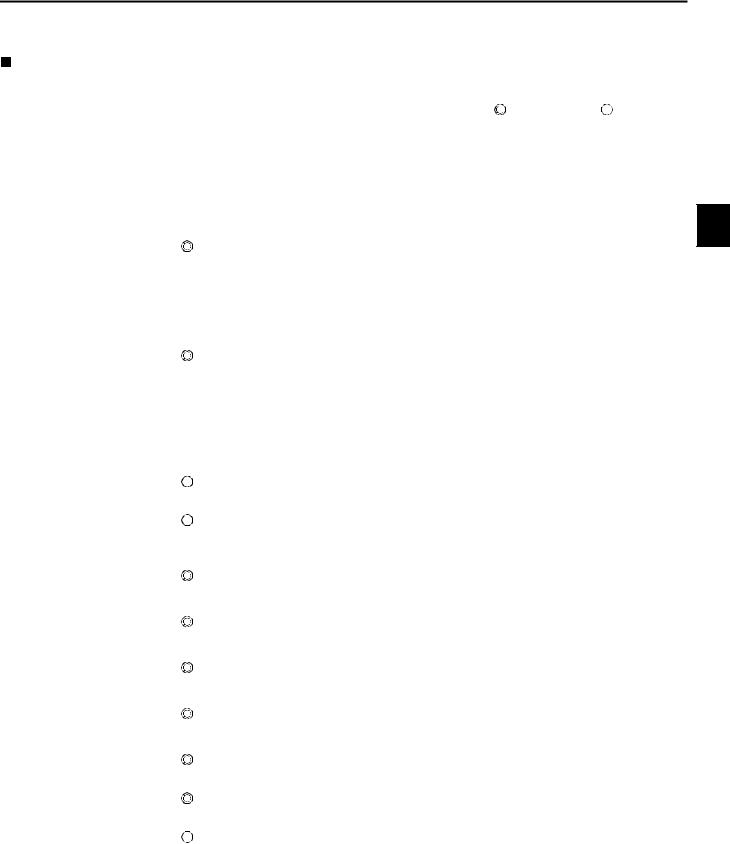
1-3
FEATURES (SELLING POINTS)
Table of selling points
|
|
|
|
mfr: manufacturer |
|
|
|||
|
|
|
|
|
|
|
|
|
|
|
|
|
|
|
: Newly adopted, : Improved |
||||
|
|
|
|
|
|
|
|
|
|
|
|
|
|
S: STD, P: OPT, –: Not available |
|||||
|
|
|
|
|
|
|
|
|
|
|
|
|
|
|
|
|
|
|
|
Selling point |
|
Function or Item |
Objective |
|
1.5 ~ |
4.0 ~ |
mfr A |
Relative |
|
|
|
|
|
|
|
3.5t |
5.0t |
|
page |
|
|
|
|
|
|
|
|
|
|
|
|
Improved performance |
|
|
|
|
|
||
|
|
|
|
|
|
|
|
|
|
Improvement in operation |
|
Power keep function |
Better performance at a low |
|
|
|
|
|
|
hours and work cycles without |
|
|
battery level |
|
S |
S |
— |
1-8 |
|
an operator noticing a decline |
|
|
|
|
|
2-2 |
|||
|
|
|
|
|
|
|
|
||
in performance |
|
|
|
|
|
|
|
|
|
|
|
|
|
|
|
|
|
|
|
Availability of different power |
|
Power select function |
A touch on a switch selects |
|
|
|
|
|
|
modes for different needs: |
|
|
optimum power mode. |
|
|
|
|
|
|
H mode: High power mode |
|
|
|
|
|
|
|
|
|
P mode: Power mode |
|
|
|
|
|
S |
|
|
1-11 |
S mode: Standard mode |
|
|
|
|
|
|
S |
— |
|
|
|
|
|
|
|
|
2-2 |
||
|
|
|
|
|
|
|
|
|
|
Other customized modes are |
|
|
|
|
|
|
|
|
|
available as well. |
|
|
|
|
|
|
|
|
|
|
Load handling power |
|
|
|
S |
|
|
|
|
|
|
|
|
|
|
|
|
||
|
|
control |
|
|
|
|
|
|
|
|
|
|
|
|
|
|
|
|
|
|
|
|
|
|
|
|
|
|
|
|
|
Improvement on operator comfort |
|
|
|
|
|
||
|
|
|
|
|
|
|
|
|
|
Improvement in ease of |
|
The entry area has been |
Ease of getting on and off |
|
|
|
|
|
|
getting on and 0ff |
|
widened by installing the |
equivalent to the engine- |
|
S |
S |
— |
1-10 |
|
|
|
battery under floor |
powered model |
|
|
|
|
|
|
|
|
|
|
|
|
|
|
|
|
Increased leg space |
|
|
Expansion of foot space |
|
S |
S |
— |
1-10 |
|
|
|
|
|
|
|
|
|
|
|
|
|
Improved serviceability |
|
|
|
|
|
||
|
|
|
|
|
|
|
|
|
|
Improved serviceability |
|
AC motor |
Need for servicing motor |
|
S |
S |
— |
1-7 |
|
|
|
|
brushes is eliminated. |
|
|||||
|
|
|
|
|
|
|
|
||
|
|
|
|
|
|
|
|
|
|
|
|
Overheat protector |
Power is reduced |
|
|
|
|
2-5 |
|
|
|
|
automatically when motor is |
|
S |
S |
— |
||
|
|
|
|
5-2 |
|||||
|
|
|
overheated. |
|
|
|
|
||
|
|
|
|
|
|
|
|
||
|
|
|
|
|
|
|
|
|
|
|
|
AC controller |
Need for servicing contactor |
|
S |
S |
— |
2-2 |
|
|
|
|
is eliminated. |
|
|||||
|
|
|
|
|
|
|
|
||
|
|
|
|
|
|
|
|
|
|
|
|
Thermal protector |
Output is reduced |
|
|
|
|
2-5 |
|
|
|
|
automatically when |
|
S |
S |
— |
||
|
|
|
|
5-2 |
|||||
|
|
|
controller is overheated. |
|
|
|
|
||
|
|
|
|
|
|
|
|
||
|
|
|
|
|
|
|
|
|
|
Reduced need for servicing |
|
Wet brake system |
Service life of brake system |
|
S |
S |
S |
5-10 |
|
brake |
|
|
is prolonged |
|
|||||
|
|
|
|
|
|
|
|||
|
|
|
|
|
|
|
|
|
|
|
|
Regenerative system |
Service life of brake system |
|
S |
S |
S |
2-5 |
|
|
|
(accelerator off) |
is prolonged. |
|
|||||
|
|
|
|
|
|
|
|||
|
|
|
|
|
|
|
|
|
|
Higher safety during servicing |
|
Jacking points under the |
Jacking points indicated for |
|
S |
S |
— |
9-2 |
|
|
|
counter weight and frame |
higher safety |
|
|||||
|
|
|
|
|
|
|
|||
|
|
|
|
|
|
|
|
|
|
1
0
11
12
13

1-4
Selling point |
|
Function or Item |
Objective |
1.6 ~ |
4.0 ~ |
mfrA |
Relative |
|
|
3.5t |
5.0t |
Page |
|||||
|
|
|
|
|
|
|||
|
|
|
|
|
|
|
|
|
|
|
|
Safety |
|
|
|
|
|
|
|
|
|
|
|
|
|
|
Improved turning stability |
|
SAS-active control rear |
Rear wheel ground grip |
|
|
|
|
|
|
|
|
stabilizer |
force increased when |
S |
S |
— |
11-6 |
|
|
|
|
required |
|
|
|
|
|
|
|
|
|
|
|
|
|
Improved material handling |
|
SAS-active mast function |
Controls front tilt angle for |
|
|
|
|
|
stability |
|
controller (front tilt angle |
high lifting, etc. |
S |
S |
— |
11-10 |
|
|
|
|
control) |
|
|
|
|
|
|
|
|
|
|
|
|
|
|
Load collapse reduction |
|
SAS-active mast function |
Controls rear tilt speed for |
|
|
|
|
|
|
|
|
controller (rear tilt speed |
high lifting, etc. |
S |
S |
— |
11-10 |
|
|
|
control) |
|
|
|
|
|
|
|
|
|
|
|
|
|
|
Operation error prevention for |
|
SAS-active mast function |
Prevents unintended fork |
S |
S |
— |
11-10 |
|
lift lever |
|
controller (key-lift interlock) |
lowering |
|||||
|
|
|
|
|
||||
|
|
|
|
|
|
|
|
|
Large reduction of natural |
|
SAS-active mast function |
Cuts off valve oil leaks |
|
|
|
|
|
drop and front tilt (1/3 of |
|
control (key-lift interlock) |
when the key switch is |
S |
S |
— |
11-10 |
|
previous values) |
|
|
turned OFF. |
|
|
|
|
|
|
|
|
|
|
|
|
|
|
Easy monitoring of SAS |
|
SAS-operation monitor, |
Easy recovery from SAS |
|
|
|
|
|
operation status |
|
indicator lamp, and |
faults |
S |
S |
— |
3-2 |
|
|
|
|
diagnosis |
|
|
|
|
|
|
|
|
|
|
|
|
|
|
Availability of maximum travel |
|
Speedometer |
Large display easy to see |
S |
S |
— |
3-4 |
|
speed control |
|
|
|
|
|
|
|
|
|
|
Speed alarm |
Warning is given when |
|
|
|
|
|
|
|
|
|
|
|
|
||
|
|
|
|
travel speed exceeds |
P |
P |
— |
3-5 |
|
|
|
|
preset level. |
|
|
|
|
|
|
|
|
|
|
|
|
|
|
|
|
Speed limiter |
Sets limits to travel speed |
S |
S |
— |
3-4 |
|
|
|
|
|
|
|
|
|
Improved visibility |
|
High-mount rear |
Visibility of forklift truck from |
P |
P |
— |
9-6 |
|
|
|
|
combination lamps |
surrounding area |
||||
|
|
|
|
|
|
|
||
|
|
|
|
|
|
|
|
|
Forward view |
|
Super-wide visible mast |
Maintains advantages of |
S |
S |
— |
10-2 |
|
|
|
|
|
internal width of wide mast. |
||||
|
|
|
|
|
|
|
|
|
|
|
|
|
|
|
|
|
|
|
|
|
Operability, etc. |
|
|
|
|
|
|
|
|
|
|
|
|
|
|
Easy operation |
|
SAS-active mast function |
Automatically sets the mast |
|
|
|
|
|
|
|
|
control (automatic fork |
vertical. |
S |
S |
— |
11-12 |
|
|
|
leveling control) |
|
|
|
|
|
|
|
|
|
|
|
|
|
|
|
|
|
Steerage, load handling |
Reduced operation power |
S |
S |
— |
— |
|
|
|
lever, accelerator pedal |
|
||||
|
|
|
|
|
|
|
|
|
|
|
|
|
|
|
|
|
|
|
|
|
Mini-lever |
|
S |
S |
P |
10-12 |
|
|
|
|
|
|
|
|
|
|
|
|
Anti roll back |
|
S |
S |
S |
2-5 |
|
|
|
|
|
|
|
|
|
Improved traveling stability |
|
Regenerative system |
Regenerative braking |
S |
S |
— |
2-5 |
|
|
|
|
(accelerator off) |
equivalent to engine brake |
||||
|
|
|
|
|
|
|
||
|
|
|
|
|
|
|
|
|
Smooth and quick switchback |
|
AC motor and AC controller |
Quick switchback operation |
S |
S |
— |
2-5 |
|
operation |
|
|
without time lag |
|||||
|
|
|
|
|
|
|||
|
|
|
|
|
|
|
|
|
Improved meter of screen |
|
Multiple display |
Legible display |
S |
S |
— |
3-2 |
|
|
|
|
|
|
|
|
|
|
Battery roll out |
|
|
|
P |
P |
— |
12-3 |
|
|
|
|
|
|
|
|
|
|

1-5
Outline of Design
Major differences from previous models
|
Item |
|
|
|
New models |
|
|
Previous models |
|
Relative |
||
|
|
|
|
Applicable |
|
Applicable |
||||||
|
|
|
|
|
page |
|||||||
|
|
|
|
|
|
model |
|
|
|
model |
||
|
|
|
|
|
|
|
|
|
|
|||
|
|
|
|
|
|
|
|
|
|
|
||
|
|
|
|
|
|
|
|
|
|
|
|
|
General |
Overhead guard |
|
|
|
2195mm |
1.6 ~ 1.8 ton |
|
2160mm |
1.6 ton |
|
||
|
height |
|
|
|
|
|
|
|
|
|
|
|
|
|
|
|
2195mm |
2.0 ton |
|
2180mm |
2.0 ton |
|
|||
|
|
|
|
|
|
|
||||||
|
|
|
|
|
|
|
|
|
|
|
||
|
|
|
|
|
2215mm |
2.5 ton |
|
2180mm |
2.5 ton |
|
||
|
|
|
|
|
|
|
|
|
|
|
||
|
|
|
|
|
2215mm |
3.0 ~ 3.5 ton |
|
2275mm |
3.0 ton |
|
||
|
|
|
|
|
|
|
|
|
|
|
— |
|
|
|
|
|
|
2310mm |
4.0 ~ 5.0 ton |
|
|
— |
— |
||
|
|
|
|
|
|
|
|
|
|
|
||
|
Wheelbase |
|
|
|
1420mm |
1.6 ~ 1.8 ton |
|
1360mm |
1.6 ton |
|
||
|
|
|
|
|
|
|
|
|
|
|
||
|
|
|
|
|
1580mm |
2.0 ~ 2.5 ton |
|
1505mm |
2.0 ~ 2.5 ton |
|
||
|
|
|
|
|
|
|
|
|
|
|
||
|
|
|
|
|
1725mm |
3.0 ~ 3.5 ton |
|
1650mm |
3.0 ton |
|
||
|
|
|
|
|
|
|
|
|
|
|
|
|
|
|
|
|
|
2080mm |
4.0 ~ 5.0 ton |
|
|
— |
— |
|
|
|
|
|
|
|
|
|
|
|
|
|
||
|
|
|
|
|
|
|
|
|
|
|
||
Motor |
Drive motor |
AC: |
12.0 / 13.3 |
kw |
1.6 ~ 1.8 ton |
DC: |
7.6 / 8.6 |
kw |
1.6 ton |
|
||
|
(72V/80V) |
|
|
|
|
|
|
|
|
|
|
|
|
AC: |
15.4 / 17.1 |
kw |
2.0 ~ 3.5 ton |
DC: |
10.1 / 10.6 |
kw |
2.0 ~ 3.0 ton |
5-2 |
|||
|
|
|||||||||||
|
|
|
|
|
|
|
|
|
||||
|
|
AC: 14.9 / 16.6 kw |
4.0 ~ 5.0 ton |
|
|
— |
— |
|
||||
|
|
|
|
|
|
|
|
|
||||
|
Pump motor |
AC: 12.0 / 13.5 |
kw |
1.6 ~ 1.8 ton |
DC: |
11.5 / 13.0 kw |
1.6 ton |
|
||||
|
(72V/80V) |
|
|
|
|
|
|
|
|
|
|
|
|
AC: |
16.9 / 18.6 |
kw |
2.0 ~ 2.5 ton |
DC: |
14.8 / 17.0 |
kw |
2.0 ~ 2.5 ton |
10-27 |
|||
|
|
|||||||||||
|
|
|
|
|
|
|
|
|
|
|
||
|
|
AC: |
16.9 / 18.6 |
kw |
3.0 ~ 3.5 ton |
DC: |
16.5 / 18.5 |
kw |
3.0 ton |
|||
|
|
|
||||||||||
|
|
|
|
|
|
|
|
|
||||
|
|
AC: 22.8 / 25.4 kw |
4.0 ~ 5.0 ton |
|
|
— |
— |
|
||||
|
|
|
|
|
|
|
|
|
||||
|
PS motor |
DC: |
1.0 / 1.1 kw |
1.5 ~ 3.5 ton |
DC: |
1.0 / 1.1 kw |
1.5 ~ 3.0 ton |
|
||||
|
(72V/80V) |
|
|
|
|
|
|
|
|
|
10-27 |
|
|
Same motor for PS as well as hydraulic oil |
4.0 ~ 5.0 ton |
|
|
— |
— |
||||||
|
|
|
|
|||||||||
|
|
|
|
|
||||||||
|
|
pump |
|
|
|
|
|
|
|
|||
|
|
|
|
|
|
|
|
|
||||
|
|
|
|
|
|
|
|
|
||||
Controller |
Traveling |
Main controller & traveling motor driver |
1.6 ~ 5.0 ton |
Traveling & load handling controller |
1.6 ~ 3.0 ton |
|
||||||
|
|
|
|
|
|
|
|
|||||
|
Load handling |
Main controller & load handling motor driver |
1.6 ~ 3.5 ton |
|
||||||||
|
|
|
|
|
|
|||||||
|
|
|
|
|
|
|
|
|
||||
|
SAS |
Controller of SAS |
1.6 ~ 5.0 ton |
|
|
— |
|
Section |
||||
|
|
includes the steerage control |
|
|
|
|
|
2, 11 |
||||
|
Steerage |
1.6 ~ 3.5 ton |
Steerage controller |
1.6 ~ 3.0 ton |
||||||||
|
|
|
|
|
|
|||||||
|
|
|
|
|
|
|
|
|
||||
|
|
Controller of main |
4.0 ~ 5.0 ton |
|
|
— |
— |
|
||||
|
|
includes the steerage control |
|
|
|
|||||||
|
|
|
|
|
|
|
|
|||||
|
|
|
|
|
|
|
|
|
||||
|
|
|
|
|
|
|
|
|
||||
Brake |
Main brake |
Wet brake |
|
1.6 ~ 5.0 ton |
Dry brake |
|
1.6 ~ 3.0 ton |
5-10 |
||||
mechanism |
|
|
|
|
|
|
|
|
|
|
|
|
Parking brake |
Parking brake system of electric switch type |
1.6 ~ 5.0 ton |
Parking brake lever of ratchet type |
1.6 ~ 3.0 ton |
5-13 |
|||||||
|
||||||||||||
|
|
|
|
|
|
|
|
|
||||
|
|
|
|
|
|
|
|
|
||||
SAS |
SAS specifications |
SAS-active control stability |
|
|
|
— |
— |
11-6 |
||||
equipment |
|
|
|
|
|
|
|
|
|
|
|
|
|
Mast function control |
|
|
|
|
|
|
|||||
|
|
|
|
|
|
|
|
|||||
|
|
• |
Front tilt angle control |
1.6 ~ 5.0 ton |
|
|
|
|
|
|||
|
|
• |
Rear tilt speed control |
|
|
— |
— |
11-10 |
||||
|
|
|
|
|
||||||||
|
|
• |
Automatic fork leveling control |
|
|
|
|
|
|
|||
|
|
• |
Key-lift interlock |
|
|
|
|
|
|
|||
|
|
|
|
|
|
|
|
|
|
|
||
|
|
|
|
|
|
|
|
|
|
|
||
Frame |
Overhead guard |
|
|
|
1055mm |
1.6 ~ 3.5 ton |
|
1030mm |
1.6 ~ 3.0 ton |
|
||
|
Clearance |
|
|
|
|
|
|
|
|
|
|
|
|
|
|
|
1075mm |
4.0 ~ 5.0 ton |
|
|
— |
— |
|
||
|
|
|
|
|
|
|
|
|||||
|
|
|
|
|
|
|
|
|
|
|
|
|
|
Step height |
|
|
|
525mm |
1.6 ~ 1.8 ton |
|
|
515mm |
1.6 ton |
|
|
|
|
|
|
|
|
|
|
|
|
|
||
|
|
|
|
|
2.0 ton |
|
|
540mm |
2.0 ~ 2.5 ton |
|
||
|
|
|
|
|
|
|
|
|
||||
|
|
|
|
|
|
|
|
|
|
|||
|
|
|
|
|
545mm |
2.5 ton |
|
|
|
|||
|
|
|
|
|
|
|
|
|
|
|||
|
|
|
|
|
|
|
|
|
|
|
||
|
|
|
|
|
3.0 ~ 3.5 ton |
|
675 (2nd) /160 (1st) |
3.0 ton |
Section |
|||
|
|
|
|
|
|
|
||||||
|
|
|
|
|
|
|
|
|
|
|
||
|
|
|
|
|
535mm |
4.0 ~ 5.0 ton |
|
|
— |
— |
9 |
|
|
|
|
|
|
|
|
|
|||||
|
|
|
|
|
|
|
|
|
|
|
|
|
|
Underclearance |
|
|
|
90mm |
1.6 ~ 1.8 ton |
|
|
110mm |
1.6 ton |
|
|
|
Center of Wheelbase |
|
|
|
|
|
|
|
|
|
||
|
|
|
|
2.0 ton |
|
|
|
|
|
|||
|
(Without load) |
|
|
|
|
|
|
130mm |
2.0 ~ 2.5 ton |
|
||
|
|
|
|
|
|
|
|
|
|
|||
|
|
|
|
|
110mm |
2.5 ton |
|
|
|
|||
|
|
|
|
|
|
|
|
|
|
|||
|
|
|
|
|
|
|
|
|
|
|
||
|
|
|
|
|
3.0 ~ 3.5 ton |
|
|
225mm |
3.0 ton |
|
||
|
|
|
|
|
|
|
|
|
||||
|
|
|
|
|
|
|
|
|
|
|
|
|
|
|
|
|
|
150mm |
4.0 ~ 5.0 ton |
|
|
— |
— |
|
|
|
|
|
|
|
|
|
|
|
||||
|
|
|
|
|
|
|
|
|
||||
Others |
Floor mat |
Equipped |
|
1.6 ~ 5.0 ton |
Nothing |
|
1.6 ~ 3.0 ton |
— |
||||
|
|
|
|
|
|
|
||||||
|
Material handling lever |
Mini-lever with armrest |
1.6 ~ 5.0 ton |
Manual lever on the front cowl |
1.6 ~ 3.0 ton |
10-12 |
||||||
|
|
|
|
|
|
|
||||||
|
Seat |
ORS seat with seat belt |
1.6 ~ 5.0 ton |
Seat with seat belt |
1.6 ~ 3.0 ton |
8-4 |
||||||
|
|
|
|
|
|
|
|
|
|
|
|
|
1
0
11
12
13
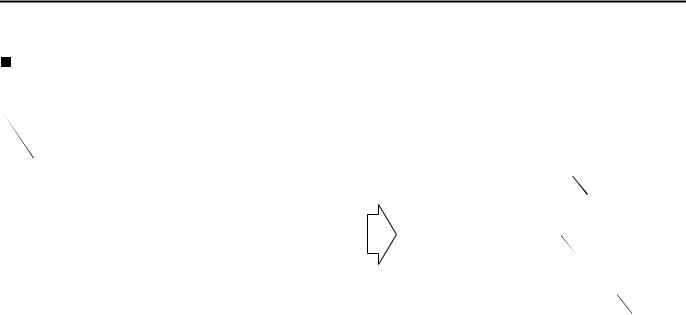
1-6
AC POWER SYSTEM
AC system in industrial trend
Industries have already employed AC power system by making use of its features. Three major features are:
|
System design |
Product level |
|
advantages |
advantages |
|
|
|
|
Simpler and smaller |
More powerful motor can |
1 |
construction of motor |
be used without |
|
|
increasing size. |
|
|
|
|
Three-phase AC control |
Wide control range offers |
2 |
realizes wider control |
a higher performance |
|
range. |
and operability. |
|
|
|
|
Motor brushes and |
Reduced maintenance |
|
contactors are |
cost as the needs for |
3 |
dispensed with. |
servicing motor brushes |
|
|
and contactors are |
|
|
eliminated. |
|
|
|
Industry |
1970 |
80 |
90 |
|
|
|
|
|
|
Machine tool |
|
|
|
|
|
DC |
|
AC |
|
|
|
|
|
|
Train |
|
|
|
|
|
DC |
|
AC |
|
|
|
|
|
|
Electric |
|
|
|
|
Automobiles (EV) |
DC |
|
AC |
|
|
|
|
|
|
Electric Forklifts |
|
|
|
|
|
|
DC |
|
|
|
|
|
|
|
Thereby industrial truck engineers worldwide have already been aware of the splendid features of AC power system to be implemented in electric forklift trucks.
New AC drive motor systems have been adopted not only in the smaller capacity models, but also in the larger capacity models. This new system resolves the opposing factors between larger output necessity and compactness.

1-7
AC power system as compared with DC power system
In the DC power system the controller will chop the battery current in repetition and control the frequency cycles of ON and OFF. The motor performance will change in proportion with the frequency cycles between ON and OFF, thereby the inching at start to the max. performance is controlled.
The AC power system in the new models includes a controller that transforms the battery current into a threephase alternating current. The motor power is controlled by changing the sinusoidal waveform (frequency, amplitude, etc.) of the three-phase alternating current.
Motor drive voltage, motor construction, and controller details differ between DC and AC power systems, as follows:
Comparison between DC and AC power systems
|
|
|
Motor voltage |
|
Motor construction |
|
|
Controller |
||||
|
|
|
|
|
|
|
|
|
|
|
|
|
|
|
|
Mean voltage |
|
|
|
|
|
|
Motor |
||
|
|
|
|
|
Commutator |
Brush |
|
|
|
|
|
|
|
|
|
ON |
|
|
|
|
|
|
|
|
|
|
|
|
|
|
|
|
Battery |
|||||
|
|
Controller |
|
|
|
|
|
|
Contactor |
|||
|
|
|
|
|
|
|
|
|
|
|||
DCpower |
|
|
|
|
|
|
|
|
|
|
|
|
system |
|
|
|
|
|
|
|
|
|
|
|
|
|
Battery |
OFF Mean voltage |
|
|
|
|
|
|
Microcomputer |
|
||
|
|
|
|
|
|
|
|
|
||||
|
|
|
|
|
|
|
|
control |
|
|||
|
|
voltage |
|
|
|
|
|
|
|
|
|
|
|
|
|
|
|
|
|
|
|
|
|
|
|
|
|
|
|
|
|
|
|
|
|
|
||
|
• A chopper circuit converts the bat- |
• |
Brushes and commutator require |
• |
Motor power can be controlled sim- |
|||||||
|
|
tery current (DC) into a rectangular |
|
servicing. |
|
|
ply via the mean DC voltage. |
|||||
|
|
waveform and controls the mean |
• |
Complex mechanism |
• |
Contactors for reversing the motor |
||||||
|
|
voltage at a desired level. |
|
|
|
|
rotation are required. |
|||||
|
|
|
|
|
|
|
|
|
|
|
|
|
|
|
|
Sine wave |
|
Stator ferrit core |
Stator coil |
|
|
|
|
|
|
|
|
Controller |
|
|
|
Battery |
||||||
|
|
|
|
|
|
|
||||||
|
|
|
|
|
|
|
|
|
|
|
|
Motor |
AC power |
|
Battery |
|
|
|
|
|
|
|
|
|
|
|
voltage |
|
|
|
|
|
|
|
|
|
|
|
system |
|
|
|
|
|
|
|
|
|
|
|
|
|
|
|
Motor |
|
|
|
|
|
|
|
|
|
|
|
|
|
|
|
|
|
Microcomputer |
|
|
||
|
|
|
voltage |
|
|
|
|
|
|
|||
|
|
|
|
|
|
|
|
control |
|
|
||
|
|
|
|
|
|
|
|
|
|
|||
|
|
|
|
|
|
|
|
|
|
|
||
|
|
|
|
|
|
|
|
|
|
|
|
|
|
|
|
|
|
|
|
|
|
|
|
|
|
|
• Controller converts battery current |
• |
Brushes and commutator, which re- |
• |
A control module converts DC into |
|||||||
|
|
(DC) into AC. |
|
quire servicing, arer not used. |
|
three-phase AC. |
||||||
|
|
|
|
• |
Compact and lightweight |
• |
Contactor for reversing the motor |
|||||
|
|
|
|
|
|
|
|
rotation are not required. |
||||
|
|
|
|
|
|
|
|
|
|
|
|
|
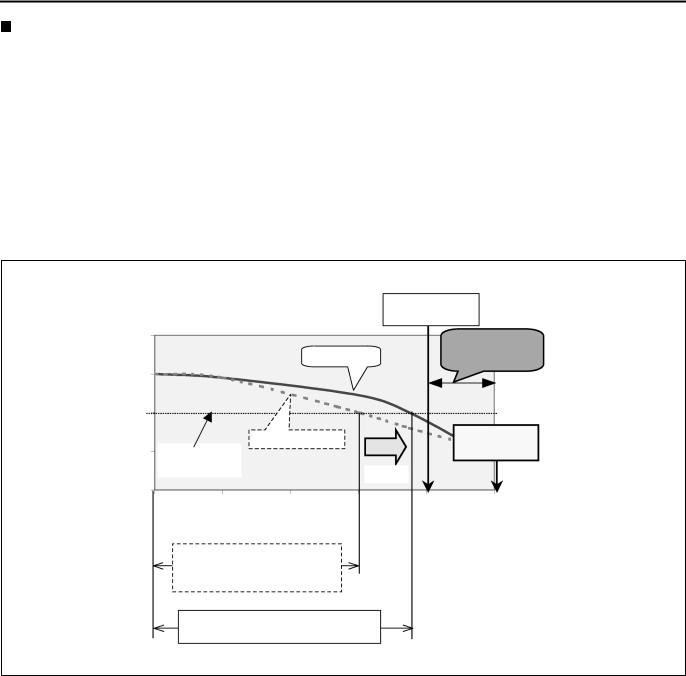
1-8
Power keep function
(Functions in power mode: P, standard mode: S)
Power keep function using the benefit of AC power system further lengthen the operation hours epochally. With conventional electric powered forklift trucks, the vehicle performance decreases gradually as the battery level goes low.
The power keep function adopted to new models takes advantage of the increased controllability provided by the AC system to keep the vehicle performance even when the battery level has become low. With this power keep function, the maximum operating hours have increased by 25%, and the number of work cycles that can be completed without the operator noticing a decline in performance has also increased by 25%.
New power keep function offers a significant and essential improvement in the material handling efficiency. (See page 2-2 for further detail.)
Battery discharge level and vehicle performance
|
|
|
|
Battery capacity |
|
|
|
|
|
warning |
|
1.1 |
|
|
|
|
Battery usage |
|
|
|
New model |
||
|
|
|
limit area |
||
1 |
|
|
|
|
|
|
|
|
|
|
|
0.9 |
|
|
|
|
|
0.8 |
|
Previous model |
|
Lift |
|
|
|
interruption |
|||
Decrease in |
|
|
|
||
performance |
|
|
25% up |
|
|
|
|
|
|
|
|
0.7 |
|
|
60% |
|
|
0% |
20% |
40% |
80% |
100% |
|
Battery discharge level (%)
Previous model (2.5 ton:S mode) Efficiency operation hour: 161min
New model (2.5 ton:S mode)
Efficiency operation hour: 200min
Even the battery indicator is flashing to indicate the charge warning, the performance level of 7FBMF series is batter than that of the former FBMF models.
In view of the battery protection, it is advisable to charge the battery before discharging to the limit.
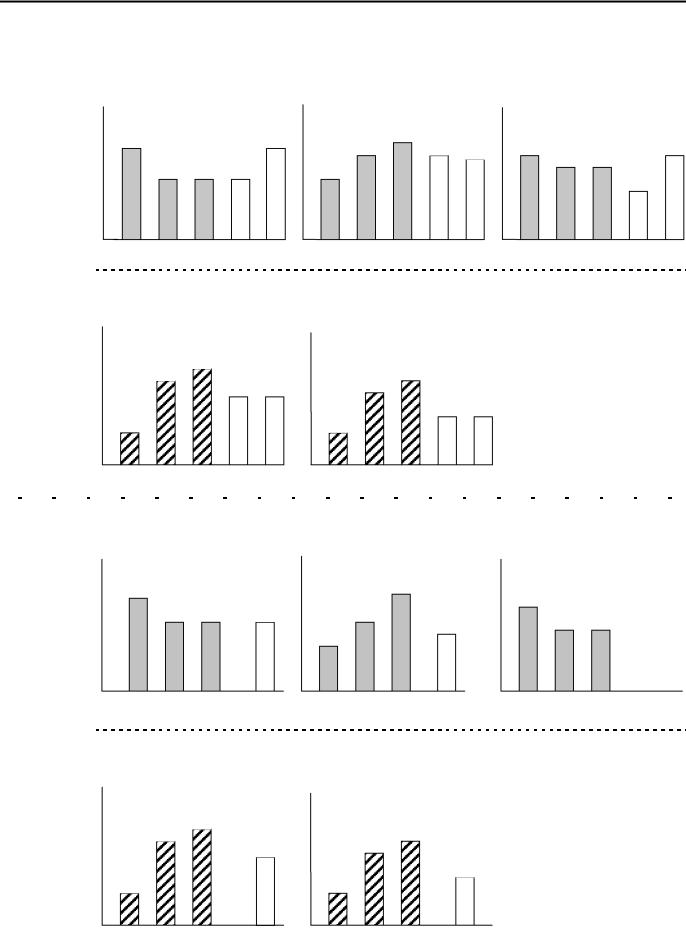
1-9
|
Performance features in comparison |
|
|
|
|
|
mfr: manufacturer |
|
|
|
|
|
|
|
|
|
|||||||||||||||||||||||||||||||||
|
|
|
|
|
|
|
|
|
|
|
|
|
|
|
|||||||||||||||||||||||||||||||||||
|
|
|
|
|
|
|
|
|
|
|
|
|
|
|
|
|
|
|
|
|
|
|
|
|
|
|
|
|
|
|
|
|
|
|
|
|
|
|
|
||||||||||
|
|
|
|
|
|
Traveling speed (km/h) |
|
|
|
|
Acceleration (sec) |
|
|
|
|
|
|
Slope climbing speed (km/h) |
|||||||||||||||||||||||||||||||
|
2.5 ton |
|
|
|
|
|
|
|
|
|
|
||||||||||||||||||||||||||||||||||||||
|
[a] |
|
|
|
|
|
|
|
|
|
|
|
|
|
[b] |
|
|
|
|
|
|
|
|
|
|
|
[c] |
|
|
|
|
|
|
|
|
|
|||||||||||||
|
|
|
|
|
|
|
|
|
|
|
|
|
|
|
|
|
|
|
|
|
|
|
|
|
|
|
|
|
|
|
|
|
|
|
|
|
|
|
|||||||||||
|
|
|
|
|
|
*: Loaded |
|
|
|
|
|
|
|
|
|
|
|
|
|
*Loaded: 0-10m |
|
|
|
|
|
|
|
|
*Loaded: 1/10 slope |
||||||||||||||||||||
|
|
|
|
|
|
|
|
|
|
|
|
|
|
|
|
|
|
|
|
|
|
|
|
|
|
|
|||||||||||||||||||||||
|
|
|
|
|
|
16 |
|
|
|
|
|
|
|
|
|
|
16 |
|
|
|
|
|
5.3 |
|
5.7 |
|
|
|
|
|
|
|
|
|
|
|
|
7.0 |
|||||||||||
|
|
|
|
|
|
|
|
|
|
|
|
|
|
|
|
|
|
|
|
|
|
|
|
5.3 |
|
5.2 |
|
6.9 |
|
|
|
||||||||||||||||||
|
|
|
|
|
|
|
|
|
|
|
|
|
|
|
|
|
|
|
|
|
|
|
|
|
|
|
|
|
|
|
|
|
|
||||||||||||||||
|
|
|
|
|
|
|
|
|
|
|
|
|
|
|
|
|
|
|
|
|
|
|
|
|
|
|
|
|
|
|
|
|
|
|
|
|
|
|
5.6 |
5.6 |
|
|
|
|
|
||||
|
|
|
|
|
|
|
|
|
|
14 |
|
14 |
|
14 |
|
|
|
|
4.6 |
|
|
|
|
|
|
|
|
|
|
|
|
|
|
|
|
|
|
|
|
||||||||||
|
|
|
|
|
|
|
|
|
|
|
|
|
|
|
|
|
|
|
|
|
|
|
|
|
|
|
|
|
|
|
|
|
5.3 |
|
|
||||||||||||||
|
|
|
|
|
|
|
|
|
|
|
|
|
|
|
|
|
|
|
|
|
|
|
|
|
|
|
|
|
|
|
|
|
|
|
|
|
|
|
|
|
|
|
|
|
|||||
|
|
|
|
|
|
|
H |
P |
S |
FBMF |
mfrA |
|
|
H |
P |
S |
FBMF mfrA |
|
H |
|
P |
|
S FBMF mfrA |
||||||||||||||||||||||||||
|
|
|
|
|
|
Efficiency operation hours (min) |
|
No of cycle (cycle) |
|
|
|
|
|
|
|
|
|
|
|
|
|
|
|
|
|
|
|
||||||||||||||||||||||
|
|
|
|
|
|
[d] (Toyota 30m cycle) |
|
|
|
|
[e] (Toyota 30m cycle) |
|
|
|
|
|
|
|
|
|
|
|
|
|
|
|
|
||||||||||||||||||||||
|
|
|
|
|
|
*Battery 500Ah |
|
|
|
|
|
|
|
|
|
|
*Battery 500Ah |
|
|
|
|
|
|
|
|
|
|
|
|
|
|
|
|
|
|
|
|
|
|||||||||||
|
|
|
|
|
|
|
|
|
|
|
|
|
200 |
|
|
|
|
|
|
|
|
|
|
|
|
|
|
|
|
|
|
|
|
|
|
|
|
|
|
|
|
|
|
|
|
|
|
|
|
|
|
|
|
|
|
|
|
|
|
185 |
|
|
|
|
|
|
|
|
|
|
|
|
|
|
131 |
|
138 |
|
|
|
|
|
|
|
|
|
|
|
|
|
|
|
|
|
|
|
|||
|
|
|
|
|
|
|
|
|
|
|
|
|
|
|
|
161 |
|
163 |
|
|
|
|
|
|
|
|
|
|
|
|
|
|
|
|
|
|
|
|
|
|
|
|
|
|
|
||||
|
|
|
|
|
|
|
|
|
|
|
|
|
|
|
|
|
|
|
|
|
|
|
|
|
|
|
|
|
|
|
111 |
|
112 |
|
|
|
|
|
|
|
|
|
|
|
|
|
|||
|
|
|
|
|
|
125 |
|
|
|
|
|
|
|
|
|
|
|
|
|
88 |
|
|
|
|
|
|
|
|
|
|
|
|
|
|
|
|
|
|
|
|
|
|
|
|
|||||
|
|
|
|
|
|
|
H |
P |
S |
FBMF |
mfrA |
|
|
H |
|
P |
|
S |
FBMF |
mfrA |
|
|
|
|
|
|
|
|
|
|
|
|
|
||||||||||||||||
|
|
|
|
|
|
|
|
|
|
|
|
|
|
|
|
|
|
|
|
|
|
|
|
|
|
|
|
|
|
|
|
|
|
|
|
|
|
|
|
|
|
|
|
|
|||||
|
|
|
|
|
|
Traveling speed (km/h) |
|
|
|
Acceleration (sec) |
|
|
|
|
|
|
Slope climbing speed (km/h) |
||||||||||||||||||||||||||||||||
|
4.5 ton |
|
|
|
|
|
|
|
|
|
|||||||||||||||||||||||||||||||||||||||
|
[f] |
|
|
|
|
|
|
|
|
|
|
|
|
[g] |
|
|
|
|
|
|
|
|
|
|
|
[h] |
|
|
|
|
|
|
|
|
|
||||||||||||||
|
|
|
|
|
|
|
|
|
|
|
|
|
|
|
|
|
|
|
|
|
|
|
|
|
|
|
|
|
|
|
|
|
|
|
|
|
|
||||||||||||
|
|
|
|
|
|
*Loaded |
|
|
|
|
|
|
|
|
|
|
|
|
|
*Loaded: 0-10m |
|
|
|
|
|
|
|
*Loaded: 1/10 slope |
|||||||||||||||||||||
|
|
|
|
|
|
|
|
|
|
|
|
|
|
|
|
|
|
|
|
|
|
|
|
|
|
||||||||||||||||||||||||
|
|
|
|
|
|
14 |
|
|
|
|
|
|
|
|
|
|
|
|
|
|
|
|
|
|
|
|
6.3 |
|
|
|
|
|
|
4.8 |
|
|
|
|
|
|
|
|
|
|
|||||
|
|
|
|
|
|
|
|
|
|
|
|
|
|
|
|
|
|
|
|
|
|
|
|
|
|
|
|
|
|
|
|
|
|
|
|
|
|
|
|
|
|
|
|
|
|
|
|||
|
|
|
|
|
|
|
|
|
|
13 |
13 |
|
|
|
13 |
|
|
|
|
|
5.9 |
|
|
|
|
5.7 |
|
|
|
|
|
|
|
|
3.4 |
3.4 |
|
|
|
|
|
||||||||
|
|
|
|
|
|
|
|
|
|
|
|
|
|
|
|
|
|
|
|
|
|
|
|
|
|
|
|
|
|
|
|
|
|
|
|
|
|
|
|
|
|
|
|
||||||
|
|
|
|
|
|
|
|
|
|
|
|
|
|
|
|
|
|
|
|
|
|
5.4 |
|
|
|
|
|
|
|
|
|
|
|
|
|
|
|
|
|
|
|
|
|
|
|
||||
|
|
|
|
|
|
|
|
|
|
|
|
|
|
|
|
|
|
|
|
|
|
|
|
|
|
|
|
|
|
|
|
|
|
|
|
|
|
|
|
|
|
|
|
|
|
|
|||
|
|
|
|
|
|
|
|
H |
|
P |
|
S |
|
|
|
mfrA |
|
|
H |
P |
S |
|
mfrA |
|
|
|
|
|
H |
|
P |
|
S |
||||||||||||||||
|
|
|
|
|
|
Efficiency operation hours (min) |
|
No of cycle (cycle) |
|
|
|
|
|
|
|
|
|
|
|
|
|
|
|
|
|
|
|
||||||||||||||||||||||
|
|
|
|
|
|
[i] (Toyota 50m cycle) |
|
|
|
|
[j] (Toyota 50m cycle) |
|
|
|
|
|
|
|
|
|
|
|
|
|
|
|
|
||||||||||||||||||||||
|
|
|
|
|
|
*Battery 700Ah |
|
|
|
|
|
|
|
|
|
|
*Battery 700Ah |
|
|
|
|
|
|
|
|
|
|
|
|
|
|
|
|
|
|
|
|
|
|||||||||||
|
|
|
|
|
|
|
|
|
|
204 |
|
218 |
|
|
|
|
|
|
|
|
|
|
|
|
|
|
100 |
|
|
|
|
|
|
|
|
|
|
|
|
|
|
|
|
|
|
|
|||
|
|
|
|
|
|
|
|
|
|
|
|
|
|
|
|
|
|
|
|
|
|
|
|
96 |
|
|
|
|
|
|
|
|
|
|
|
|
|
|
|
|
|
|
|
|
|||||
|
|
|
|
|
|
|
|
|
|
|
|
|
|
|
|
|
|
|
174 |
|
|
|
|
|
|
|
|
|
|
|
|
|
|
|
|
|
|
|
|
|
|
|
|
|
|
|
|||
|
|
|
|
|
|
|
|
|
|
|
|
|
|
|
|
|
|
|
|
|
|
|
|
|
|
|
|
|
|
|
|
|
|
|
|
|
|
|
|
|
|
|
|
|
|
|
|
||
|
|
|
|
|
|
|
|
|
|
|
|
|
|
|
|
|
|
|
|
|
|
|
|
|
|
|
|
|
|
|
80 |
|
|
|
|
|
|
|
|
|
|
|
|
|
|
|
|||
|
|
|
|
|
|
133 |
|
|
|
|
|
|
|
|
|
|
|
|
|
67 |
|
|
|
|
|
|
|
|
|
|
|
|
|
|
|
|
|
|
|
|
|
|
|
|
|||||
H |
P |
S |
mfrA |
H |
P |
S |
mfrA |
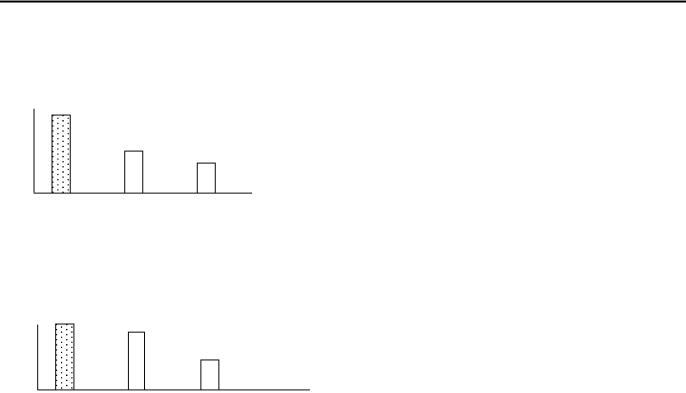
1-10
Operator comfort
(1)Improvement of the ease of getting on and off
By new battery layout, improved the ease of getting on and off
(mm)560
290
260
7FBMF FBMF mfrA
Entry clearance (2.5 ton) [a]
(2)Improvement of comfort
By new battery layout, improved the leg space
(mm)640 604
555
7FBMF FBMF mfrA
Leg space (2.5 ton) [b]

1-11
Power select function
Using the power select function, the operator can select a desirable power mode.
Even though the conventional models also had a power selection switch, it only produced a small difference in the acceleration.
New models use an AC motor instead of a DC motor.
Since and AC motor is simpler and smaller, it becomes possible to install a motor that produces an output higher than that of a conventional DC motor.
In addition, the operator can select appropriate mode from the following power modes simply by operating a switch.
• High power mode |
: The most active mode with the quickest cycle-time |
<H mode> |
|
|
|
• Power mode |
: The highest efficiency mode with quick cycle time and long operation hour |
<P mode> |
|
|
|
• Standard mode |
: The longest operation hour mode with the performance equivalent to MFRA |
<S mode> |
|
|
|
In order to further satisfy the individual customer, a power select function has been provided.
The power select function enables the operator to select one from six power modes, including H, P and S modes, for traveling. The operator can select H mode for operations requiring power and high performance. Select S mode for long time operations, providing the operator with optimum performance to suit the operator’s needs and greatly enhance efficiency.
<7FBMF25>
Cycles
44
43
42
41
High power mode <H mode>
 Previous
Previous
model
: Fixed mode
:Selectable only through power select function
 : Power select function default setting
: Power select function default setting
Power mode <P mode>
Standard mode <S mode>
30m cycle pattern |
|
180min |
240min |
|
Efficient operation hours
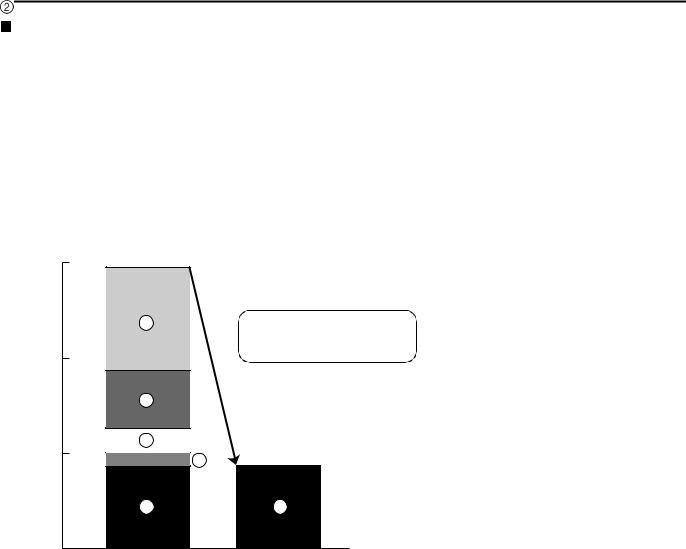
1-12
Reduced maintenance cost
The following particular items are inherent to the conventional electric powered models.
Supplying distilled water to the battery
Material handling motor brush replacement
Material handling motor contactor replacement
Traveling motor brush replacement
Traveling motor contactor replacement
The new 7FBMF model eliminates the need for brush and contactor replacement because the new AC motor does not have brushes and the new AC controller does not have contactors.
The average customer can benefit from this by an annual cost savings of 69% for maintenance expenditures.
Eur (USD) |
|
1460 (1490) |
1Eur = 0.98USD |
|
|
|
|
||
1500 |
|
|
|
|
|
519 |
5 |
Annual Cost Saving 69% |
|
|
|
|||
1000 |
|
|
by Eliminating |
~ |
|
|
|
|
|
|
294 |
4 |
|
|
500 |
127 |
3 |
451 (460) |
|
69 |
|
|
||
|
2 |
|
||
|
|
|
||
|
451 |
1 |
1 |
|
0 |
|
Previous |
New model |
|
|
|
|
||
|
|
model |
|
|
Taking advantage of the wider control range of the AC power system, a regenerative system is adopted.
The AC induction motor generates a braking force when the vehicle is traveling with the accelerator pedal at rest. Also the electromotive force generated in the AC motor, while the accelerator pedal is released, converts the braking effect energy into electrical energy that is sent to the battery.
This regenerative system increases the operation hours. At the same time, the regenerative system improves the traveling feel because it allows the operator to use less brake pedal force to slow the truck down. Furthermore, the regenerative system reduces load on the brake system, slowing down brake lining wear and decreasing the brake maintenance costs.

1-13
Stabilizing features
The world-first System of Active Stability (SAS), adopted by the 7FB series models, is available for the new models, too.
Using the SAS the new models achieve the stability level equivalent to that achieved by the 7FB series models. The following outlines the SAS. For more details of the SAS option, refer to Section 11 “SAS”.
|
Stability feature |
Outline |
|
|
|
|
Rear stabilizer (swing lock) |
The rear wheel swing mechanism is locked at high lift-heights and |
|
|
heavy loads, and during a quick turn to obtain a better ground grip |
|
|
force from all four wheels. |
|
|
|
Mast function control |
|
|
|
|
|
|
Front tilt angle control |
The front tilt angle is smaller at high heights and heavy loads; |
|
|
greater at low heights and light loads. |
|
|
|
|
Rear tilt speed control |
The rear tilt speed is slower at high heights and faster at low |
|
|
heights. |
|
|
|
|
Key-lift interlock |
The lift lever cannot function by inadvertent contact. |
|
|
|
|
Automatic fork leveling control |
A push on a control button followed by a front tilt operation tilts the |
|
|
mast until the forks are horizontal. |
|
|
|
Improvement on operability
1.Mini lever
The hydraulic control levers are displaced to the arm rest fore-front and optimal length, and spacing are given on basis of human engineering. An operator can manipulate the control lever with a hand on the arm rest. Fine operation adjustment can be achieved with the display. The control lever position is adjustable vertically as well as to lengthwise.
Pleasant material handling operation with less fatigue can be ensured.
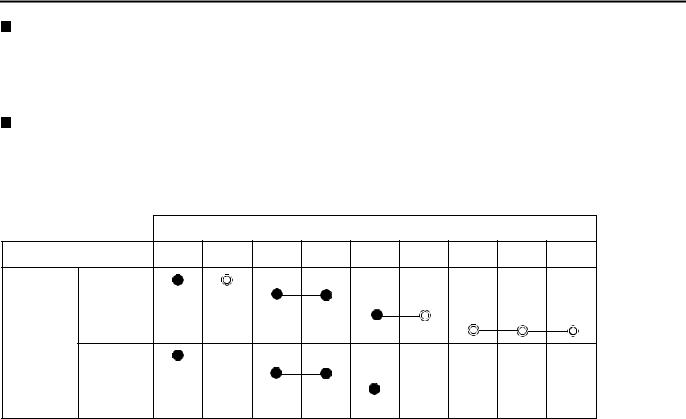
1-14
Anti-rollback
The anti-rollback function is provided to prevent the truck from rolling down on a slope. This is realized by making use of the combined features of the drive motor electric brake and the parking brake.
Restarting can be done smoothly without rolling down.
Model line-up
The model line-up has been widened by the development to 3.5 ~ 5 ton class new model ranges; besides, the 1.8 ton model is added onto the 1 ~ 3 ton classes to meet with varied needs from the markets.
 : New
: New  : Continuation
: Continuation
Capacity (kg)
1600 |
1800 |
2000 |
2500 |
3000 |
3500 |
4000 |
4500 |
5000 |
7FBMF |
|
|
|
|
|
|
|
|
TOYOTA |
|
|
|
|
|
|
|
|
FBMF |
|
|
|
|
|
|
|
|

2-1
CONTROLLER
|
Page |
MAIN CONTROLLERS ............................................................. |
2-2 |
General ................................................................................. |
2-2 |
Controller Configuration Diagram .............................. |
2-3 |
MAIN FEATURES OF CONTROLLER ................................. |
2-5 |
2
0
11
12
13
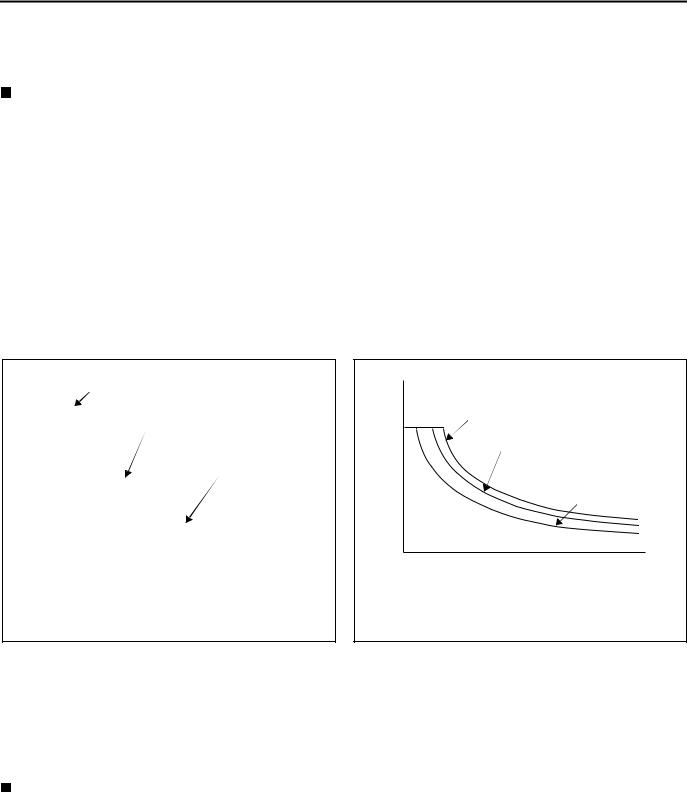
2-2
MAIN CONTROLLERS
General
AC system
The AC motor drive system controller has been provided with:
•Microcomputer-assisted travel inverter control (converts DC to three-phase AC)
•CAN (Controller Area Network) communication function between main controller and traveling/material handling controller.
•Communication function between multiple display and SAS controller.
This is a multi-functional controller with advanced electronics technology.
The controller offers the power select function and power keep function that take full advantage of the AC power system.
Power select function: Allows the operator to select from three traveling modes, H (High power) mode, P (Power) mode, and S (Standard) mode.
Power keep function: Maintains a high performance level even when the battery level becomes low and increases stress-free operation hours. (Available when P or S mode is selected.)
|
AC motor maximum output |
|
Torque |
AC power system output |
|
characteristics |
||
|
||
|
DC power system output |
|
|
characteristics (DC motor |
|
|
maximum output) |
Revolution
Compared to the DC motor, the AC motor has higher output and a range of output characteristics is obtainable from the increased output.
AC and DC power system output characteristics with fully charged battery
Torque |
AC power system output |
|
|
|
characteristics with discharged battery |
DC power system output characteristics with discharged battery
Revolution
When the battery is discharged, the AC motor provides output characteristics closer to those of a fully charged battery than a DC motor does.
Compared with a DC motor of an equivalent size, an AC motor has a higher output.
The output characteristics of an AC motor are determined by the amplitude and frequency of the alternating current output by the controller.
The controller has a map stored in its memory of the optimum combinations of the current and frequency. Using these, the optimum output characteristics can be obtained for all conditions. When the power selection switch is operated, the controller switches the map and changes the output characteristics. The power select function thus enables the output characteristics to be changed in accordance with the vehicle usage conditions.
Power keep function
With a DC power system, the output characteristics are determined by the controller output voltage. The maximum output, therefore, is the output from the motor when the battery voltage is fully applied (chopper duty 100%). The output will decrease with the battery voltage as the battery is discharged.
With an AC power system, however, it is possible to maintain a high performance even when the battery level becomes low because the combination of the amplitude and frequency of the alternating current is changed as the battery level goes low.
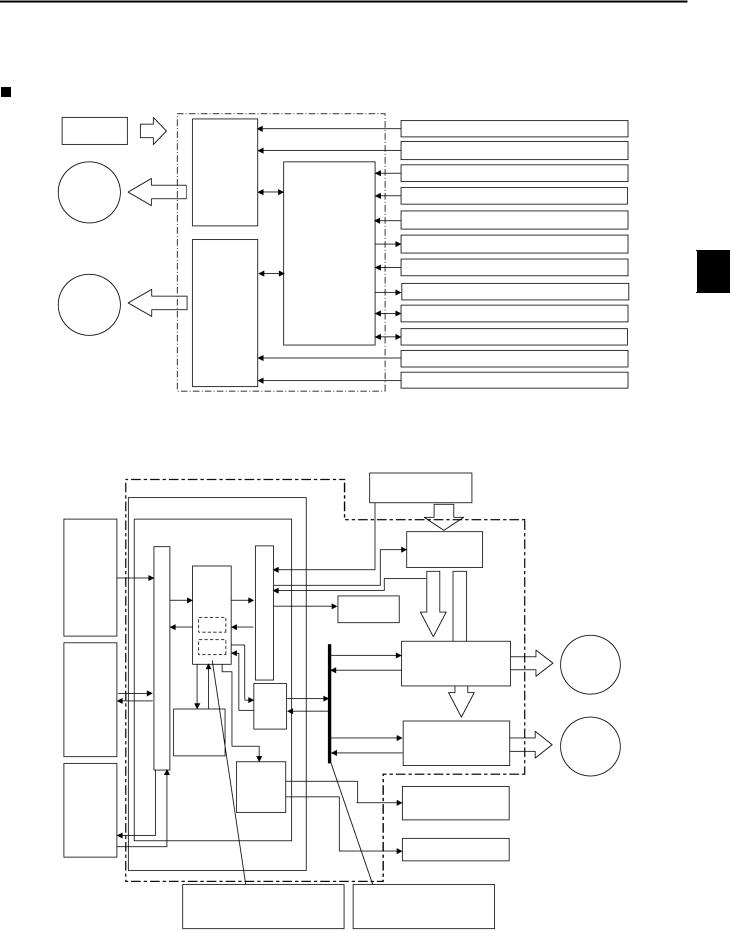
2-3
Controller Configuration Diagram
1. Traveling & Load handling controller
System configuration diagram
|
Battery |
|
|
|
Traveling motor temperature sensor |
|
|
|
|
|
|
|
|
|
|
Traveling |
|
Traveling speed sensor |
||
|
|
|
|
|
||
|
|
motor |
|
|
Direction switch |
|
|
Traveling |
driver |
|
|
Traveling accelerator potentiometer |
|
|
AC motor |
|
|
|
||
|
|
|
|
|
|
|
|
|
|
Main |
|
Brake switch |
|
|
|
|
|
Parking brake valve |
||
|
|
|
controller |
|||
|
|
|
|
|
Material handling potentiometer |
|
|
Material |
Material |
|
|
Oil control |
valve |
|
handling |
|
|
|||
|
handling |
motor |
|
|
SAS(with PS) controller |
|
|
AC motor |
driver |
|
|
||
|
|
|
|
|
||
|
|
|
|
|
Multiple display |
|
|
|
|
|
|
Material handling motor temperature sensor |
|
|
|
|
|
|
Material handling speed sensor |
|
|
Traveling and material handling controller |
|
||||
|
|
|
|
|
||
|
Controller internal configuration diagram |
|
|
|
||
|
|
|
|
|||
|
|
|
|
|
||
|
Traveling and material handling controller |
|
|
|
||
|
Main controller |
|
|
|
Battery |
|
|
CPU board |
|
|
|
|
|
|
|
|
|
|
Power supply |
|
|
|
|
|
|
contactor |
|
|
Sensors |
|
|
|
|
|
|
and |
|
|
|
|
|
|
switches |
|
|
|
|
|
|
|
CPU |
I |
Cooling fan |
|
|
|
|
|
/ |
|
|
|
|
|
RAM |
O |
|
|
|
|
|
|
|
|
|
|
|
I |
ROM |
|
|
|
|
/ |
|
|
|
Traveling motor driver |
Traveling |
|
|
O |
|
|
|
|
AC motor |
|
Multiple |
|
CAN |
|
|
|
|
display |
|
|
|
|
|
|
|
|
I/O |
|
|
|
|
EEPROM |
|
|
Material handling |
Material |
|
|
|
|
|
|
||
|
|
|
|
|
motor driver |
handling |
|
|
|
|
|
|
AC motor |
|
|
Solenoid |
|
|
|
|
|
|
|
drive |
|
|
|
|
SAS |
|
circuit |
|
Oil control valve |
|
|
(with PS) |
|
|
|
|
|
|
|
|
|
|
|
|
|
controller |
|
|
|
|
|
|
|
|
|
|
Parking brake valve |
|
|
|
Comfortable operability is |
|
CANBus |
|
|
|
|
realized by making fine control |
|
Controller Area |
|
|
|
|
using microcomputer. |
|
Network Bus |
|
|
|
|
|
|
|
|
|
2
0
11
12
13
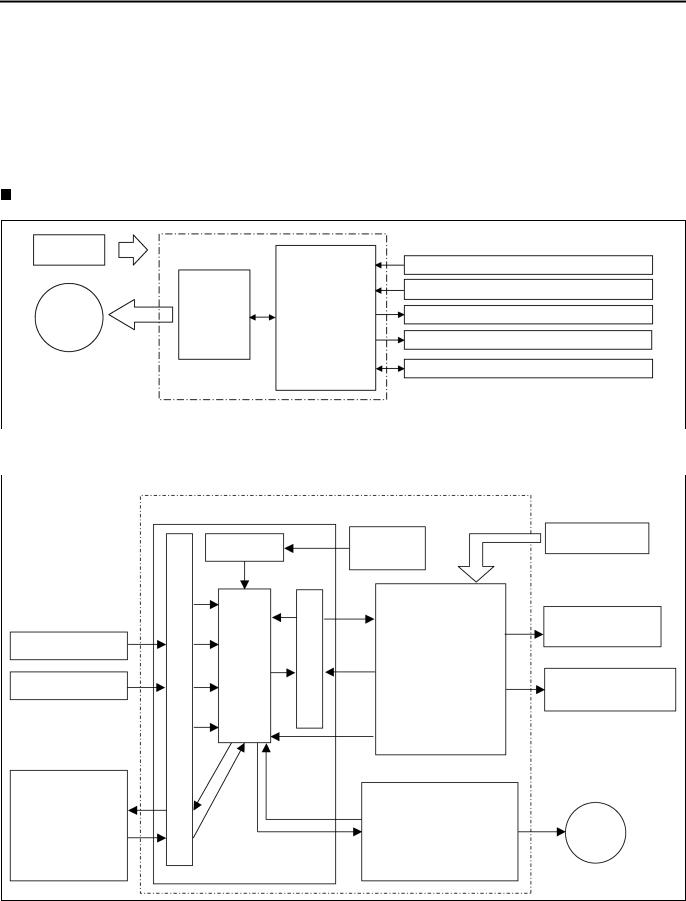
2-4
CPU: |
Central Processing Unit |
ROM: |
Read Only Memory (with built-in control program) |
RAM: |
Random Access Memory (memory content lost when power turned off) |
EEPROM:Electrically Erasable Programmable Read Only Memory (memorizes data required for control and er-
|
ror code.) |
I/O: |
Input/Output interface |
CANI/O: |
Controller Area Network Input/Output interface |
2. SAS (With Power Steering) Controller
System configuration diagram
Battery
|
|
Tire angle sensor |
|
|
Wheel angle sensor |
|
PS circuit |
Control circuit |
PS motor |
Swing solenoid |
|
|
|
Knob position correcting valve |
|
|
|
Main controller |
|
SAS (with PS) controller |
|
|
|
|
|
|
|
Controller internal configuration diagram |
|
|
|
|
|
|
|
|
|
|
|
SAS (with PS) controller |
|
|
|
CPU board |
|
|
|
I/O |
Yaw rate |
Battery |
|
|
||
|
sensor |
|
|
|
|
|
|
|
|
|
Swing solenoid |
Tire angle sensor |
|
I |
|
|
|
/ |
|
|
|
|
CPU |
|
|
|
|
O |
Power & solenoid |
|
|
|
|
|
||
Wheel angle sensor |
I |
|
drive board |
Knob position |
|
/ |
|
|
correcting valve |
|
|
|
|
|
|
O |
|
|
|
Main controller |
*PS motor drive |
*PS motor |
|
main circuit |
|
|
|
The portions marked with * are applicable only to 7FBMF 16 ~ 35 models. CPU: Central Processing Unit
I/O: Input/Output interface

2-5
MAIN FEATURES OF CONTROLLER
1.Regenerative system (accelerator off)
When the vehicle travels with the accelerator off, a braking force produced by the motor generates electricity, which is retrieved by the battery. The working of the regenerative system extends the available operation hours and the service life of brake linings. At the same time, the regenerative system improves the travel speed controllability and stability because it allows the operator to use the soft braking force exerted by the motor. Even if the direction lever is at the neutral position, the regenerative system will function when the accelerator is off.
2.Regenerative system (brake pedal depressed)
Regenerative system is operated when the brake pedal is depressed as well, which allows to extend the available operation hours and the service life of brake lining.
Even if the direction is at the neutral position, the regenerative system will function when the brake pedal is depressed.
3.Regenerative system (switch back)
The switch back operation (It means the directional change during traveling) also regenerate electricity like the previous model. Furthermore the AC controller in the new model has no contactor for traveling so that the switch back operates smoother than before.
4.Power select function
Three traveling and material handling modes are available from a selection switch on the multiple display: H (high power) mode, P (power) mode, and S (standard) mode.
5.Advanced power select function (option)
The advanced power select function allows the operator to select a traveling power mode and a material handling power mode independently from each other. It also allows the operator to define a mode other than H, P, and S.
6.Power keep function
The power keep function maintains the vehicle performance at a high level even when the battery level is low. With the new models, stress-free operation hours for a battery charged have increased.
(The power keep function is available only when the operator selects P or S mode.)
7.Auto-off system
If the operator leaves the vehicle with the key switch ON, the auto-off system forcibly shuts down the controller (equivalent to key switch OFF) after a preset period to prevent wasteful expenditure of energy. To restart the vehicle, turn the key switch OFF and then ON.
8.Seat switch
The seat switch does not allow the vehicle to travel as well as any material handling to operate by the minilevers unless someone is on the operator's seat.
9.Anti-rollback function
The anti-rollback function makes it easy to start the vehicle on an inclined surface. This function is achieved by controlling both the drive motor and the brake system.
10.2-speed travel speed control
The 2-speed travel speed control switch sets a speed limit. The set value is adjustable by a switch on the multiple display.
11.Thermal Protector Overheat warning:
Temperature in the controllers and motors are monitored by temperature sensors. If an abnormally high temperature is detected, the controller output is reduced to prevent overheating. The display will warn the operator.
2
0
11
12
13

2-6
12.Battery level computation
The controller monitors decrease in the battery voltage, computes the remaining capacity, and displays it as the current battery level.
13.Diagnostic function
The diagnostic function can detect abnormalities in the traveling controller and the material handling controller, operation mechanisms such as the accelerator, and sensors. When an abnormality is detected, the diagnostic function outputs a diagnostic code and takes the appropriate measure.
14.Analyzer function
The multiple display has an analyzer mode that can be used for troubleshooting or for testing operation mechanisms and motor drivers.
15.Over-discharge warning function
When the remaining capacity level reaches a specified level, the multiple display shows a warning and the load handling operation is restricted.
This will protect the battery and will urge the operator to charge the battery.
It is possible to release this restriction temporarily by turning the key switch off at once before resetting as emergency measures.
16.Return-to-neutral function
If the operator turns the key switch ON with the direction lever at the forward or reverse position or with the accelerator pedal depressed, the vehicle will not start. The operator has to return the direction lever and accelerator pedal to their neutral positions once in order to allow it to restart.
17.Parking brake ON warning
The buzzer sounds when the operator attempt to start the truck with the parking brake switch turned ON.
18.Parking brake OFF warning
The buzzer sounds to warn the operator when moving from the drive seat without the parking brake switch turned on.
19.Mini-lever control
Based on operation signals of the mini-lever, the main controller controls material handling operation by controlling solenoid valves and the material handling controller.

3-1
MULTIPLE DISPLAY
|
Page |
MULTIPLE DISPLAY INDICATION |
....................................... 3-2 |
MULTIPLE DISPLAY FUNCTIONS ....................................... |
3-3 |
SERVICE FUNCTIONS ............................................................. |
3-9 |
3
0
11
12
13
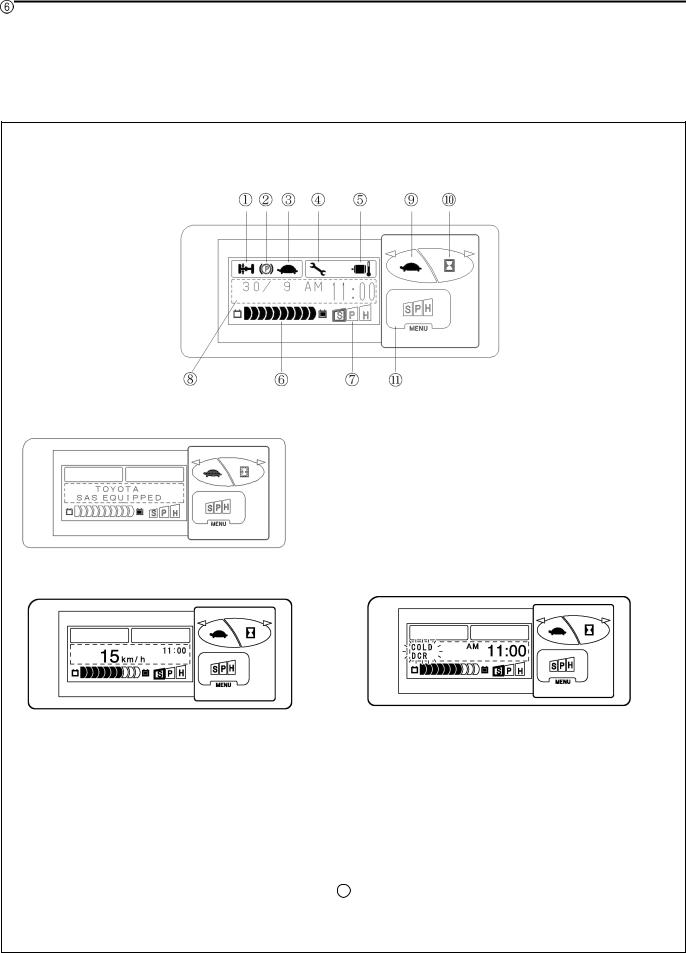
3-2
MULTIPLE DISPLAY INDICATION
General
Various essential data with regard to the truck status, warning signs, setting, meters, etc. are visible by switching display.
(Indication of  -
- will be changed according to the functional operation.)
will be changed according to the functional operation.)
During parking
Initial screen after the key switching on
During traveling |
Upon error occurrence |
No. |
Description |
No. |
Description |
|
|
|
|
|
Swing lock indicator |
|
Power select indicator |
|
|
|
|
|
Parking brake indicator |
|
Multiple display area |
|
|
|
|
|
Travel 2nd speed setting indicator |
|
Travel 2nd speed control set switch |
|
|
|
|
|
Diagnostic mode indicator |
|
Hour meter select switch |
|
|
|
|
|
Overheat warning indicator |
11 |
Power select switch |
|
|
|
|
|
Battery capacity indicator |
|
|
|
|
|
|
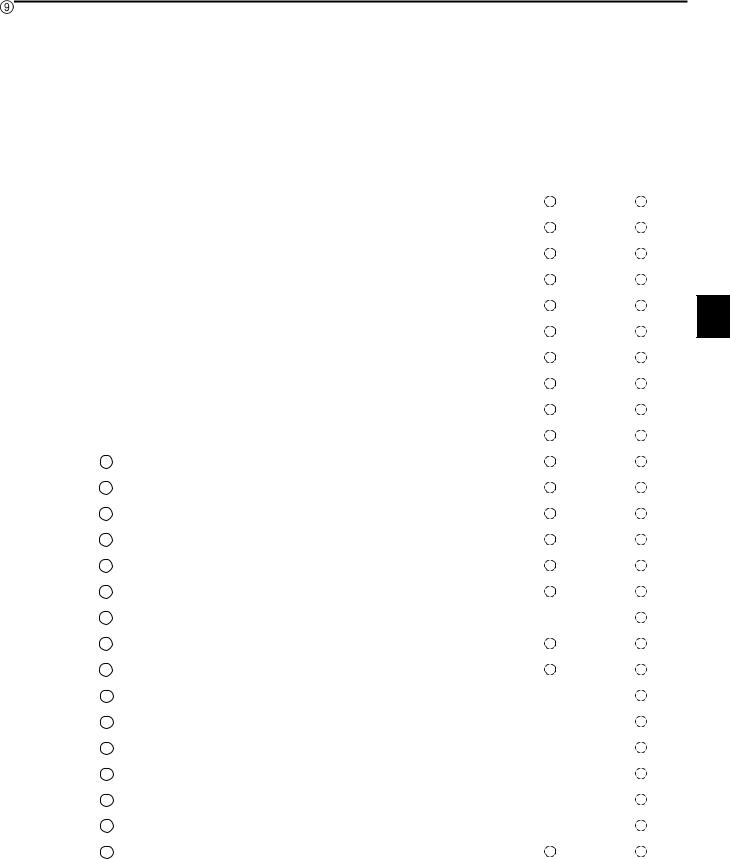
3-3
MULTIPLE DISPLAY FUNCTIONS
Table of Multiple Display Functions
 : Available
: Available
—: Not available
|
|
|
Easy model |
All-round |
Functions |
|
|
model |
|
|
|
(standard) |
||
|
|
|
(optional) |
|
|
|
|
|
|
|
|
|
|
|
|
|
Battery capacity indicator |
|
|
|
|
|
|
|
|
|
Speedometer |
|
|
|
|
|
|
|
Status |
|
Travel 2nd speed setting indicator |
|
|
|
|
|
|
|
display |
|
Swing lock indicator |
|
|
|
|
|
|
|
|
|
|
|
|
|
|
Parking brake indicator |
|
|
|
|
|
|
|
|
|
Power select indicator |
|
|
|
|
|
|
|
|
|
Power select function |
|
|
|
|
|
|
|
Level |
|
Travel power control level setting |
|
|
|
|
|
|
|
setting |
|
Material handling power control level setting |
|
|
|
|
|
|
|
|
|
|
|
|
|
|
Travel 2nd speed control level setting |
|
|
|
|
|
|
|
|
11 |
Battery over-discharge warning |
|
|
|
|
|
|
|
|
12 |
Low battery capacity warning |
|
|
|
|
|
|
|
|
13 |
Overheat warning |
|
|
|
|
|
|
|
Warning |
14 |
Parking brake ON warning |
|
|
|
|
|
|
|
15 |
Parking brake OFF warning |
|
|
|
|
|
|
||
|
|
|
|
|
|
16 |
Return to neutral warning |
|
|
|
|
|
|
|
|
17 |
Over speed alarm |
— |
|
|
|
|
|
|
|
18 |
Diagnostic code display |
|
|
|
|
|
|
|
|
19 |
Key switch on hour meter |
|
|
|
|
|
|
|
|
20 |
Travel or material handling motors service hour meter |
— |
|
|
|
|
|
|
|
21 |
Travel motor service hour meter |
— |
|
|
|
|
|
|
Integrating |
22 |
Material handling motor service hour meter |
— |
|
|
|
|
|
|
meters |
23 |
Lap time meter |
— |
|
|
|
|||
|
|
|
|
|
|
24 |
Odometer |
— |
|
|
|
|
|
|
|
25 |
Trip meter |
— |
|
|
|
|
|
|
|
26 |
Calendar/Clock |
|
|
|
|
|
|
|
3
0
11
12
13
